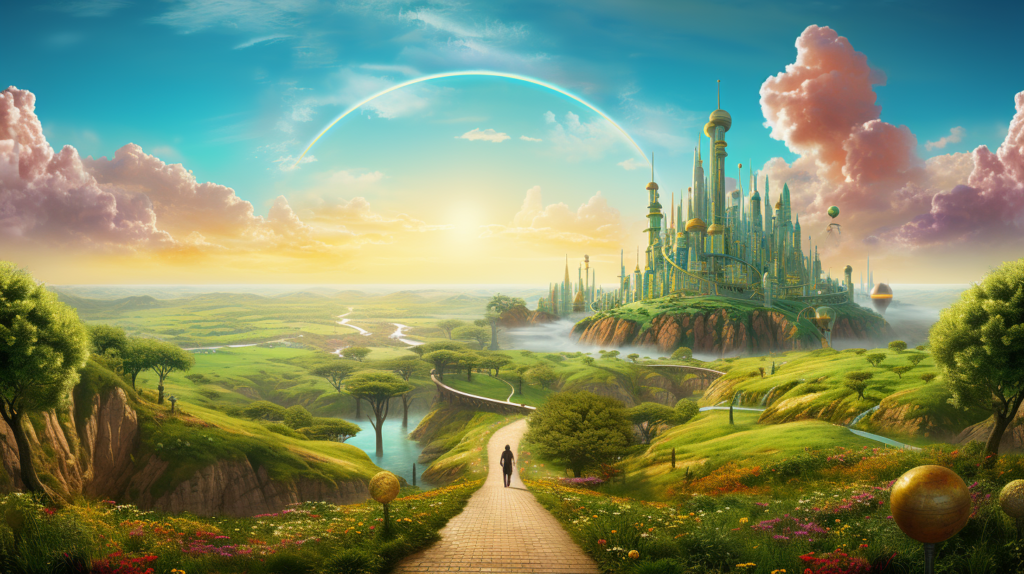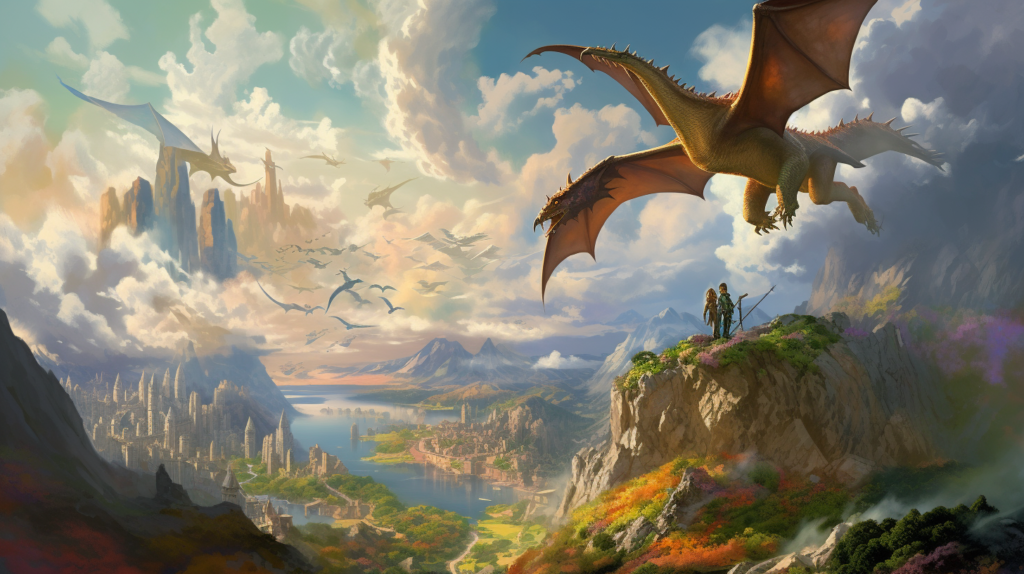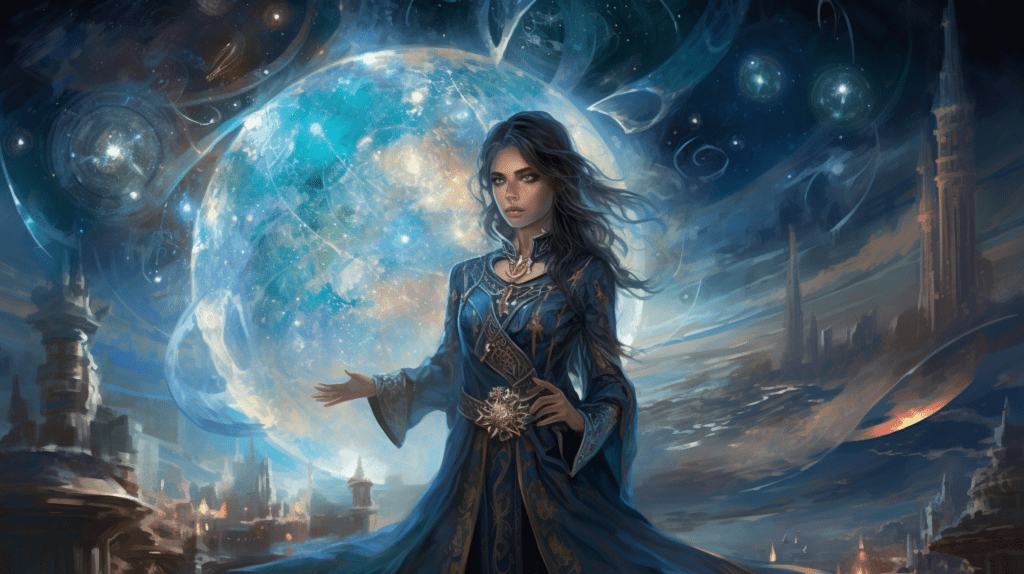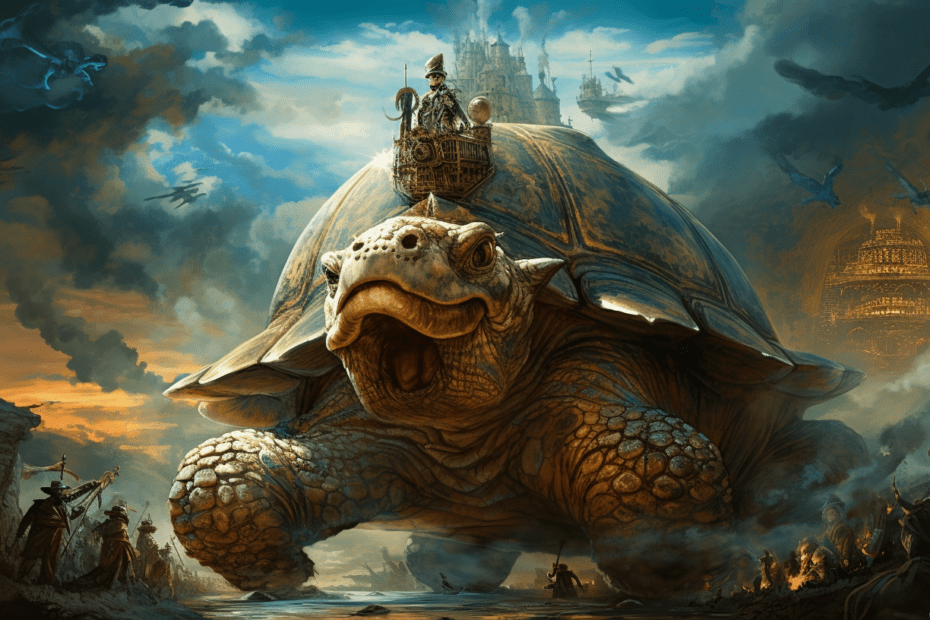Video: What is Paracosms: The Power of Imaginary Worlds
(Directly playing the video will automatically display subtitles in your language. If the subtitles are not in your language, you can go to Youtube to use the subtitle function.
If you like my content, you can also subscribe for more.
Have you ever found yourself engrossed in the rich, intricate universes of Middle-earth or Narnia, marveling at their detailed landscapes, histories, and unique characters? Such fascinating worlds, born from the minds of their creators, are examples of what’s known as a “paracosm” — a term that captures the essence of the human capacity for boundless imagination.
Define Paracosm: What are Paracosms?

The word “paracosm” refers to detailed, made-up worlds that are usually created by kids or teenagers. Many times, these make-believe worlds can continue to grow and develop even when the creators become adults, showing how powerful their imagination can be. The term “paracosm” comes from two Greek words: “para,” which means alongside or beyond, and “cosm,” which means world or universe. So, a paracosm is like a whole other universe that exists side by side with our real world, but it’s made up entirely in someone’s imagination. Consequently, a paracosm characterizes an immersive, alternate universe that exists beyond the bounds of our known world.
The term “paracosm” was first introduced by Ben Vincent, a self-proclaimed paracosmist. Vincent’s work builds upon earlier research by Robert Silvey, a researcher for the BBC. Silvey’s research into private speech and pretend play provided valuable insights into the mental constructs of paracosms.
Each paracosm is uniquely devised, often featuring elaborate geographies, with landscapes ranging from the utterly fantastical to closely resembling earthly terrains. They possess a distinctive history that may span millennia, encompassing epic narratives of creation, civilizations, conflicts, and resolutions. These narratives, no matter how fantastical, maintain a high level of internal consistency, showcasing the meticulous thought invested in their construction.
In addition to geography and history, language is another key aspect in many paracosms. Creators may develop complex languages, sometimes multiple, complete with their own syntax, vocabulary, and scripts, enhancing the realism and depth of the imagined world.
Paracosms are usually also full of characters, which could be humans, magical creatures, or entirely new kinds of beings. The creators usually feel very connected to these characters and spend a lot of time thinking about who they are, what their relationships are like, and what kind of societies they live in.
Even though each Paracosms can be very different from each other and can last for different amounts of time, they all have something in common. They’re all really well-thought-out and consistent within their own rules. This shows how creative and clever the people who make them are. These worlds are like a peek into how well humans can imagine and build complex worlds.
What are Some Examples of Paracosms in Literature and Media?

Paracosms have frequently found their way into celebrated literature and media. Worlds like Middle-earth by J.R.R. Tolkien, Pandora from the movie Avatar by James Cameron, and Discworld by Terry Pratchett were all once paracosms in the minds of their creators before they became part of our cultural landscape.
Such creations often become an enduring legacy of their creators, demonstrating how personal paracosms can resonate with broad audiences. The complex narratives, relatable characters, and carefully constructed landscapes offer an escape, an opportunity for audiences to explore these worlds, fostering empathy, broadening perspectives, and sparking creativity.
Here are some notable examples of paracosms in media and literature:
1.Middle Earth (J.R.R. Tolkien’s The Lord of the Rings)
Middle Earth, conceived by J.R.R. Tolkien, is a richly woven paracosm. Its geography stretches from the peaceful, rolling hills of the Shire, to the snowy peaks of the Misty Mountains, to the desolate plains of Mordor. This world is home to a variety of races like Elves, Dwarves, Hobbits, and Men, each with their own cultures and histories. The Elves are immortal, wisdom-filled beings with a deep connection to nature, while Dwarves are industrious miners and builders. Tolkien even developed unique languages for these races, with the Elven languages, Quenya and Sindarin, being the most detailed. Middle Earth’s history is detailed across Ages, from the creation of the world and the battles against Morgoth to the rise and fall of kingdoms and the final defeat of Sauron. This depth and richness make Middle Earth a fully-fledged paracosm.
2.Narnia (C.S. Lewis’s The Chronicles of Narnia)
Narnia, from C.S. Lewis’s series “The Chronicles of Narnia”, is an enchanting paracosm where animals talk, magic thrives, and mythical creatures exist. Geographically diverse, it spans from the Eastern Ocean to the Western Wild, encompassing various landscapes including dense forests, towering mountains, and sparkling rivers. This world is inhabited by a mix of familiar animals, fantastic beasts like centaurs, fauns, and giants, and talking animals, a unique characteristic of Narnia. The cosmology of Narnia is equally engaging, with its creation depicted in “The Magician’s Nephew”, where Aslan, the lion, sings the world into existence. Its history is filled with epic battles, dynastic changes, and significant events primarily related to the interactions between Narnia and our world, Earth. The depth and breadth of Narnia’s lore, its engaging and diverse inhabitants, and the creative magic interwoven into its fabric make it a compelling paracosm.
3.Hogwarts/Harry Potter Universe (J.K. Rowling’s Harry Potter series)
The Harry Potter universe, devised by J.K. Rowling, is a spellbinding paracosm centered on the magical school, Hogwarts, but extending far beyond. Besides Hogwarts, with its enchanted halls, myriad creatures, and shifting staircases, the world brims with a plethora of magical locations. These include the bustling Diagon Alley, mysterious Forbidden Forest, and the Ministry of Magic, the wizarding government. The world is inhabited by a society of witches and wizards who operate in secrecy from Muggles (non-magical people). These magical folks have their own history, such as the rise and fall of dark wizards like Grindelwald and Voldemort, and unique cultural elements like Quidditch, a popular sport played on broomsticks. They even have a magical education system, evident in schools like Hogwarts, Beauxbatons, and Durmstrang. The complexities of this universe extend its scope beyond the main narrative, qualifying it as a paracosm.
4.Westeros (George R.R. Martin’s A Song of Ice and Fire)
The world of “A Song of Ice and Fire” by George R.R. Martin, particularly Westeros, is a comprehensive paracosm. Westeros, a continent marked by severe winters and summers, is divided into several distinct regions, each ruled by different noble families. From the freezing lands Beyond the Wall to the sun-soaked Dorne, the geographical diversity is immense. Its inhabitants include noble families, knights, peasants, and mythical creatures like direwolves and dragons. The complex political system revolves around the Iron Throne, resulting in intriguing power struggles. Across the Narrow Sea is Essos, a continent with free cities, nomadic horse tribes, and ancient, mysterious places. Each region boasts its own unique culture, language, and history, like the Valyrian Freehold’s dragonlords and the rise and fall of dynasties in Westeros. This level of detail gives the world depth, realism, and longevity, making it an epitome of a paracosm.
5.Pandora (James Cameron’s Avatar)
Pandora, the imaginative brainchild of director James Cameron from the movie “Avatar,” is an alien moon with an exotic, bioluminescent landscape and a variety of unique, interdependent organisms. This paracosm is known for its lush, vibrant rainforests filled with towering trees like the Hometree and the Tree of Souls, gargantuan waterfalls, floating mountains, and strange, beautiful fauna and flora, many with bioluminescent properties. Pandora’s native species, the Na’vi, are sentient beings with their own complex language created by linguist Dr. Paul Frommer and a deep spiritual culture that reveres the interconnectedness of all life forms. They form symbiotic bonds with creatures like the Banshee, which they use for transportation. The ecosystem of Pandora functions as a vast neural network, allowing the organisms and the moon itself to interact, embodying the Gaia hypothesis. The thorough detailing of the flora, fauna, cultures, and ecosystems of Pandora creates a rich, fully realized paracosm.
6.Springfield (The Simpsons)
Springfield, the fictional town in the long-running TV show “The Simpsons,” is a unique paracosm modeled after an archetypal American town. Though its geographical location is a running gag, Springfield’s detailed environment is full of notable landmarks, including Moe’s Tavern, Springfield Elementary School, the nuclear power plant where Homer works, and the iconic Simpson family home at 742 Evergreen Terrace. The town boasts a diverse cast of over a hundred recurring characters, each with their own quirks, personalities, and backstories, from Apu Nahasapeemapetilon, the Kwik-E-Mart owner, to Montgomery Burns, the tyrannical power plant owner. The series explores various cultural and societal issues through these characters and the town itself. Springfield’s lore keeps growing, as episodes add new events, historical tidbits, and personal details to this vibrant, dynamic world. This level of detail, coupled with an extensive cast and evolving narrative, makes Springfield a captivating paracosm.
7.Discworld (Terry Pratchett’s Discworld series)
“Discworld,” created by Sir Terry Pratchett, is an intriguing paracosm characterized by its peculiar physical properties and vivid inhabitants. The world, a flat disc carried by four colossal elephants standing on a gigantic turtle named Great A’Tuin, cruises through space. Discworld defies normal physics, instead operating on a ‘narrative’ physics where belief can influence reality, leading to peculiar phenomena like million-to-one chances occurring nine times out of ten. The world is teeming with a variety of inhabitants – humans, witches, wizards, dwarfs, trolls, and various mythological creatures. Unseen University, in the city of Ankh-Morpork, is the hub for wizards and a source of many magical happenings. The Discworld has its own complex socio-political systems, cultures, and even a rich history of cataclysmic events. With its unique logic, humor, and vast array of characters, Discworld is a deeply developed and endlessly fascinating paracosm.
8.The Star Wars Universe
The Star Wars Universe, conceptualized by George Lucas, is a quintessential paracosm with vast galaxies, unique species, intricate political systems, and diverse cultures. It’s made up of countless planets and moons, each with distinct ecosystems and inhabitants – from the desert world of Tatooine to the city-covered Coruscant. This universe hosts various species like the Wookiees, Ewoks, Droids, and the Yoda’s species, each with its unique traits and cultures. Intricate political narratives revolve around the democratic Galactic Republic, the dictatorial Galactic Empire, and the rebellious Rebel Alliance. The Force, a ubiquitous metaphysical power, is the foundation of several religious and philosophical beliefs, affecting the universe’s balance. The extensive galactic history spans thousands of years, including wars, political upheavals, and Jedi-Sith conflicts. Additionally, the Star Wars expanded universe introduces new stories and characters, further enriching this detailed paracosm.
9.Azeroth (World of Warcraft)
Azeroth, the primary setting of the “World of Warcraft” (WoW) franchise, is a digital paracosm rich in lore, diverse races, cultures, and distinct geographies. Spanning several continents like Eastern Kingdoms, Kalimdor, and Northrend, Azeroth hosts a variety of environments ranging from dense forests and snowy mountains to barren deserts and mystical islands. The world is home to a multitude of races including Humans, Orcs, Night Elves, Dwarves, Trolls, and Undead, each with its own unique culture, languages, and history. The game’s narrative weaves together epic quests, ancient prophecies, and colossal battles, creating a complex and captivating history. The game’s interactive nature allows players to explore this rich world, form alliances, complete quests, and contribute to the world’s lore. This high level of interaction and the depth of lore make Azeroth an exemplary paracosm.
10.Marvel Universe
The Marvel Universe, a collective creation of comic book writers and artists at Marvel Comics, is an elaborate paracosm that intricately intertwines the lives of numerous superhero characters. This universe encompasses Earth, including recognizable cities like New York, as well as fictional locations like Wakanda, the technologically advanced African nation, and Latveria, ruled by supervillain Doctor Doom. The universe extends beyond Earth to include alien worlds like the Kree Empire, Skrull planets, and Asgard, the celestial home of Thor. Alternate realities, such as the Negative Zone or the Quantum Realm, add further layers of complexity. The Marvel Universe also includes a multifaceted timeline, with events spanning from the Big Bang to the far future, filled with time-travel, alternate timelines, and retcons. All of these elements, combined with a vast roster of characters and interlinking storylines, create a comprehensive, deeply immersive paracosm.
The Purpose and Impact of Paracosms

Child development psychologists have taken a keen interest in the study of paracosms, suggesting that they function as ways for children to orient themselves in reality. Creating a paracosm is seen as an exercise in world-building, a way for young minds to grapple with and make sense of complex concepts relating to society, relationships, ethics, and identity.
Paracosms often serve as a refuge or a coping mechanism, particularly in the case of childhood trauma, loss, or maladaptive conditions. This can be seen in the work of Emily Brontë and her siblings, who, after their mother and sisters’ deaths, created a paracosm called Gondal as a means of navigating their grief.
Meanwhile, paracosms can also stimulate creativity and problem-solving skills. They provide a safe and flexible space where children can experiment, take risks, and learn from their mistakes without facing real-world consequences. Some research suggests paracosm play is an indicator of high creative potential and is often seen in individuals recognized for their high intellectual giftedness.
For example in a study titled “Imaginary Worldplay in childhood and Maturity and its Impact on adult creativity” published in Creativity Research Journal in 2006 aimed to explore the relationship between creating imaginary worlds, or paracosms, during childhood and the ability to think creatively in adulthood. The study compared two groups: MacArthur Fellows, who are recognized for their creativity, and students from Michigan State University (MSU).
The researchers asked these groups questions to understand how common it was for them to create imaginary worlds during their childhood and whether this creative play influenced their adult work. Previous studies suggested that such imaginative play was rare and mostly linked to arts.
However, the findings of this study were different. They discovered that creating paracosms was quite common among MSU students (between 3% to 12% reported having done it). Moreover, it was even more frequent among the highly creative MacArthur Fellows (between 5% to 26%). Interestingly, it wasn’t just the artists who reported this childhood play, but scientists and social scientists too.
Additionally, many of the MacArthur Fellows who created paracosms as kids saw a connection between their early imaginative play and their creative work as adults. These findings suggest that creating imaginary worlds in childhood might act as a sort of “early training” for creativity, and it’s a topic that deserves more investigation.
Paracosms as Therapy

Paracosms can serve as therapeutic sanctuaries, offering an unconventional, yet powerful, form of self-therapy. These private worlds provide a safe and controlled environment that can facilitate the process of emotional healing and cognitive rehabilitation. They allow individuals to confront and manage their traumas, fears, and insecurities in a way that is both manageable and meaningful.
A compelling example of this therapeutic application of paracosms is the story of Mark Hogencamp. Hogencamp was the victim of a brutal assault that left him with severe brain damage and Post-Traumatic Stress Disorder (PTSD). Struggling with his recovery and grappling with the traumatic memories of the attack, Hogencamp sought solace and healing in the creation of his own paracosm, a miniature WWII-era Belgian town named “Marwencol.”
Marwencol was not just an imaginary construct but a physically realized world, intricately crafted and populated with dolls symbolizing people from Hogencamp’s real life. Each character, each narrative woven into the fabric of Marwencol, reflected aspects of Hogencamp’s own experiences and emotions. They became vessels for him to project his fears, his hopes, and his journey towards recovery.
In the process of curating this microcosm, Hogencamp was able to navigate his trauma in a non-threatening and manageable way. The paracosm served as a narrative tool that enabled him to reconstruct and make sense of his traumatic experience, thereby facilitating his emotional healing and cognitive rehabilitation. Marwencol, thus, underscored the potential therapeutic power of paracosms, highlighting their role as creative, effective, and personal means of coping with trauma and adversity.
Is Paracosm Dangerous ? A Word of Caution

While paracosms can be wonderful outlets for creativity, solace, and intellectual exploration, it’s essential to maintain a balance. Immersion in a paracosm should not replace engagement with the real world. These imaginary worlds are most beneficial when they serve as complements to our real-world experiences, providing a space for reflection, creativity, and problem-solving while ensuring we remain connected to reality.
As captivating and beneficial as paracosms can be, a word of caution is necessary. The creation and maintenance of these immersive, imaginative worlds should never eclipse one’s engagement with reality. While paracosms can serve as fantastic outlets for creativity, solace, intellectual exploration, and even therapy, they must remain in balance with the tangible world we inhabit.
Paracosms, by their very nature, are intense and absorbing. They offer a level of control and predictability that reality often lacks, making them enticing places to retreat. However, too much immersion could lead to an unhealthy disconnection from reality, jeopardizing essential real-world interactions and experiences. This disengagement might result in difficulty dealing with life’s unpredictabilities, forming real-world relationships, or fully participating in society.
Ideally, paracosms should exist as complementary spaces to our real-world experiences rather than substitutes. They should provide a platform for reflection, innovation, and problem-solving without severing our ties to the real world. Engaging with our paracosms can help us make sense of reality and process complex emotions, but it is equally crucial to apply these insights and experiences to our tangible world.
Therefore, while we acknowledge and celebrate the profound impact of paracosms, we must also remain cognizant of the need to balance these imaginary realms with our lived realities. It is this balance that ensures the full spectrum of benefits that paracosms can offer, from sparking creativity to fostering emotional resilience, without compromising our grounding in the real world.
Paracosms are a testament to the boundless imagination and adaptability of the human mind. Whether they serve as an intellectual exercise, a coping mechanism, a creative outlet, or a therapeutic tool, these intricate imaginary worlds have far-reaching impacts. They influence literature, media, and the arts, and can also contribute to personal and intellectual development. As we continue to explore and understand the role of paracosms, we unlock further insights into creativity, resilience, and the power of the human mind.
References:
- Silvey, R., & MacKeith, S. (2019). The paracosm: A special form of fantasy. In Organizing early experience (pp. 173-197). Routledge.
- MacKeith, S. A. (1983). Paracosms and the development of fantasy in childhood. Imagination, Cognition and Personality, 2(3), 261-267.
- Root-Bernstein, M., & Root-Bernstein, R. (2006). Imaginary worldplay in childhood and maturity and its impact on adult creativity. Creativity Research Journal, 18(4), 405-425.
